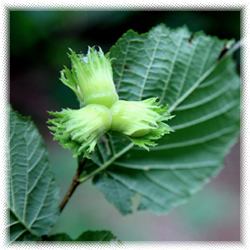Hazelnut Corylus avellana

- Common Names
- Hazelnut Oil
- Botanical Name
- Corylus avellana
- Family
- BETULACEAE
Medicinal Uses & Benefits of Hazelnut Oil
![]() How to Use|
Side Effects |
Plant & Garden|
How to Use|
Side Effects |
Plant & Garden|
- Medicinal Uses: * Massage Oils
* Skin Care
- Properties: * Astringent * Emollient
- Parts Used: Nut Oil, nuts
How to Use: Hazelnut
Hazelnut oil is a good carrier oil in aromatherapy applications, it has a slightly astringent action that is good for all skin types, but especially for those with oily skin. Hazelnut oil is high in
Oleic acid - 75.9% - and contains Vitamin E making it a good carrier oil for aromatherapy applications. Hazelnut oil does have the ability to filter out some of the suns rays, and you will find it in many suncare products.
Preparation Methods & Dosage :Use as a carrier oil in aromatherapy or as a general skin care oil. Not suited for culinary use.
Plant Description

CAM Lindman, Bilder ur Nordens Flora 1917-1926
The Common Hazel (Corylus avellana) is a species of hazel native to Europe and Asia. It is typically a shrub reaching 3-8 m tall, but can reach 15 m. The name "hazelnut" applies to the nuts of any of the species of the genus Corylus. This hazelnut or cobnut, the kernel of the seed, is edible and used raw or roasted, or ground into a paste. Hazelnuts are rich in protein and unsaturated fat. Moreover, they contain significant amounts of thiamine and vitamin B6, as well as smaller amounts of other B vitamins. Hazelnuts are extensively used in confectionery, hazelnut butter is being promoted as a more nutritious spread than its peanut butter counterpart, though it has a higher fat content.











